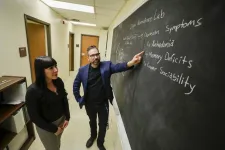(Press-News.org) The sense of smell is highly influenced by the cues from other senses, while the sense of sight and hearing are affected to a much lesser extent, shows a new study in Journal of Neuroscience.
A popular theory of the brain holds that its main function is to predict what will happen next, so it reacts mostly to unexpected events. Most research on this topic, called predictive coding, has only focused on what we see, but no one knows if the different senses, such as smell, work in the same way.
To figure out more about how smell relates to how we handle different sensory impressions, the researchers conducted a study with three experiments, two behavioural experiments, and one experiment using the brain imaging method fMRI at Stockholm University Brain Imaging Centre (SUBIC).
“The main finding is that smelling was much more dependent on predictions than vision was. This is interesting because many people think that smell is primitive and reactive, when our research shows it is in fact quite sophisticated and proactive,” says Stephen Pierzchajlo, PhD Student at the Department of Psychology, and main author of the study.
The study shows how important it is for our different senses to be able to use correct cues when we classify different sensory impressions.
“We have all experienced that we react to when an unexpected smell appears, for example when we enter someone’s flat and encounter a new smell. Our research shows that the sense of smell is highly influenced by the cues from other senses, while the sense of sight and hearing are affected to a much lesser extent,” says Jonas Olofsson, professor at the Department of Psychology, and co-author of the study.
The researchers also show that when the brain tries to identify odors that it had not expected, both the olfactory and visual brains are activated, despite the absence of visual cues in the task.
“The olfactory brain thus has a completely unique way of processing smells and it is about whether the smells are expected or not. The sense of smell warns us of smells that we had not expected, and engages the visual brain, perhaps to be able to see what it is that smells. It’s a smart function because we humans are so bad at recognizing smells if we don’t get clues,” says Jonas Olofsson.
In the experiments, participants listened to spoken word cues, such as “lemon”, and then received a picture or smell, and participants quickly decided whether it matched with the cue, for example with a lemon picture or smell, or did not match, for example with a rose picture or smell.
“We noticed that overall, the expected pictures and smells led to quicker decisions, which fits well with predictive coding theory. We used the difference in response speed to compare the senses with each other – a bigger delay for unexpected stimuli means that the sense relies more on predictions,” says Stephen Pierzchajlo.
The study is the first concluded part of his PhD research.
“The human sense of smell is not a reactive, but a proactive sense. It uses a unique brain strategy to process unexpected smells in order to understand what the smells are,” says Stephen Pierzchajlo.
Facts about the study
Three experiments were conducted in the study, two behavioral experiments and one fMRI-experiment using the brain imaging method fMRI at Stockholm University Brain Imaging Centre (SUBIC).
Sixty-nine participants completed the first behavioral experiment. Fifty participants completed the second behavioral study.
For the fMRI-experiment, data for 15 participants were first collected and analyzed. Then, 32 healthy volunteers participated in the fMRI portion of the study.
In all three experiments, the reseachers used a set of four familiar stimuli (lavender, lilac, lemon and pear) that were repeatedly presented as smells, pictures or spoken words, in order to achieve high and comparable accuracy rates and thus unbiased response-time assessments.
More information
The article “Olfactory categorization is shaped by a transmodal cortical network for evaluating perceptual predictions” is published in Journal of Neuroscience https://www.jneurosci.org/content/early/2024/03/29/JNEUROSCI.1232-23.2024
END
The sense of smell is influenced by cues from other senses
2024-04-05
ELSE PRESS RELEASES FROM THIS DATE:
RNA that doesn’t age
2024-04-05
Certain RNA molecules in the nerve cells in the brain last a life time without being renewed. Neuroscientists from Friedrich-Alexander-Universität Erlangen-Nürnberg (FAU) have now demonstrated that this is the case together with researchers from Germany, Austria and the USA. RNAs are generally short-lived molecules that are constantly reconstructed to adjust to environmental conditions. With their findings that have now been published in the journal Science, the research group hopes to decipher the complex aging process of the brain and gain a better understanding of related degenerative diseases.
Most cells in the human ...
Study finds many younger people from high income neighborhoods jumped the eligibility queue for COVID-19 vaccines in NYC
2024-04-05
Despite vaccine shortages, many younger people in New York City accessed vaccines ahead of schedule, particularly in high-income areas, according to new research at Columbia University Mailman School of Public Health. Low-income areas with high proportions of older people demonstrated lower coverage rates than wealthier areas in the first three months of vaccine rollout, and higher mortality over the year. The findings are published in the Journal of Urban Health.
“A vaccine program that prioritized those at greatest risk of COVID-19-associated morbidity and mortality would have prevented more deaths than the strategy that was implemented,” said Nina Schwalbe, adjunct ...
Rapid, simultaneous detection of multiple bacteria achieved with handheld sensor
2024-04-05
Hear the words E. coli or salmonella and food poisoning comes to mind. Rapid detection of such bacteria is crucial in preventing outbreaks of foodborne illness. While the usual practice is to take food samples to a laboratory to see the type and quantity of bacteria that forms in a petri dish over a span of days, an Osaka Metropolitan University research team has created a handheld device for quick on-site detection.
Led by Professor Hiroshi Shiigi of the Graduate School of Engineering, the team experimented with a biosensor that can simultaneously detect multiple disease-causing bacterial species within an hour.
“The palm-sized device for detection ...
Suicides among US college student athletes have doubled over past 20 years
2024-04-05
The number of suicides among US college student athletes has doubled over the past 20 years, finds an analysis of data from the National Collegiate Athletic Association (NCAA), published online in the British Journal of Sports Medicine.
Suicide is now the second most common cause of death after accidents in this group of young people, with rates highest among cross-country competitors, the findings show.
US suicide rates rose by around 36% across all age groups between 2001 and 2021, note the researchers. But the evidence ...
The Lancet: Prostate cancer cases expected to double worldwide between 2020 and 2040, new analysis suggests
2024-04-05
The Lancet: Prostate cancer cases expected to double worldwide between 2020 and 2040, new analysis suggests
Annual prostate cancer cases are projected to rise from 1.4 million in 2020 to 2.9 million in 2040, and annual deaths to increase by 85% to almost 700,000 over the same timeframe, mainly among men in low-and middle-income countries (LMICs).
The Lancet Commission on prostate cancer argues that the ‘informed choice’ programme for prostate cancer screening with PSA testing, which is common in high-income countries ...
Britain began industrializing in the 17th century – over a 100 years earlier than history books claim
2024-04-05
Britain was already well on its way to an industrialised economy under the reign of the Stuarts in the 17th century – over 100 years before textbooks mark the start of the Industrial Revolution – according to the most detailed occupational history of a nation ever constructed.
Built from more than 160 million records and spanning over three centuries, the University of Cambridge’s Economies Past website uses census data, parish registers, probate records and more to track changes to the British labour force from the Elizabethan era to the eve of World War One.
The research shows that 17th century Britain saw a steep decline ...
Bladder cancer treatment can be better targeted and more effective, trials show
2024-04-05
Testing for tumour DNA in the blood can successfully identify advanced bladder cancer patients who will not relapse following surgery, new research shows.
This could allow doctors to target treatments more effectively to those who need it, and spare those patients for whom further treatment is unnecessary, researchers say.
The findings from the screening phase of the IMvigor011 Phase III trial are presented today [Friday 5 April] at the European Association of Urology Congress in Paris.
They show that just over 90% of muscle invasive bladder cancer (MIBC) patients with a ...
Ocean floor a 'reservoir' of plastic pollution, world-first study finds
2024-04-05
New research from CSIRO, Australia’s national science agency, and the University of Toronto in Canada, estimates up to 11 million tonnes of plastic pollution is sitting on the ocean floor.
Every minute, a garbage truck’s worth of plastic enters the ocean. With plastic use expected to double by 2040, understanding how and where it travels is crucial to protecting marine ecosystems and wildlife.
Dr Denise Hardesty, Senior Research Scientist with CSIRO, said this is the first estimate of how much plastic waste ends up on the ocean floor, where it accumulates before being ...
Scientists discover potential treatment approaches for polycystic kidney disease
2024-04-04
Researchers have shown that dangerous cysts, which form over time in polycystic kidney disease (PKD), can be prevented by a single normal copy of a defective gene. This means the potential exists that scientists could one day tailor a gene therapy to treat the disease. They also discovered that a type of drug, known as a glycoside, can sidestep the effects of the defective gene in PKD. The discoveries could set the stage for new therapeutic approaches to treating PKD, which affects millions worldwide. The study, partially funded by the National Institutes of Health (NIH), is published in Cell Stem Cell.
Scientists ...
UTEP study: prairie voles display signs of human-like depression
2024-04-04
EL PASO, Texas (April 4, 2024) – Psychology researchers at The University of Texas at El Paso are making progress towards understanding the biological underpinnings of depression, a leading cause of disability that affects approximately 280 million people around the world.
In a study published this April in the Journal of Affective Disorders, UTEP psychologist Sergio Iñiguez, Ph.D., and his co-authors make the case that prairie voles, small rodents that are found throughout the central United States and Canada, can be effectively used as animal models to further the study of ...



